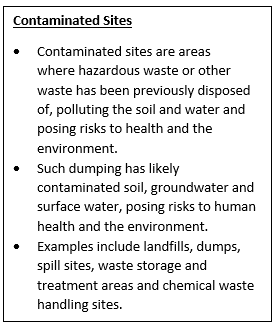SYLLABUS
GS-3: Environmental Conservation
Context: Recently, the Union Environment Ministry has notified Environment Protection (Management of Contaminated Sites) Rules, 2025 under the Environment Protection Act 1986.
More on the News
- These rules provide a legal framework for identifying, assessing and remediating chemically contaminated sites across India.
- The rules also provide for voluntary remediation of sites that are not already identified as contaminated.
- Prior to this, there was no formal legal structure, despite several such sites being identified over decades.
Key Provisions of the New Rules

- The local body or district administration, on its own or on receipt of a complaint from the public, shall identify an area affected with contaminants and list all such areas as suspected contaminated sites in its jurisdiction on a centralised online portal.
- District administration to report suspected sites biannually to the State Pollution Control Board (SPCB).
- The district administration is required to prepare half-yearly reports on “suspected contaminated sites.”
- State Boards or Reference Organisations must:
- Conduct preliminary assessment within 90 days of being informed.
- Carry out detailed survey within the next 3 months to confirm contamination.
- Assessment involves checking if levels of 189 hazardous chemicals (as per Hazardous and Other Wastes Rules, 2016) exceed safe limits.
- The notification names 189 contaminants and their response level for agricultural, residential, commercial and industrial areas.
- Confirmed contaminated sites will be publicly notified and access restrictions imposed.
- These rules do not cover contamination arising from radioactive waste, mining operations, marine oil pollution and solid waste dump sites, as these are regulated under separate legislation.
- Preliminary and detailed site assessments may be funded by the Central Government through the Environmental Relief Fund (Public Liability Insurance Act, 1991) and supported by state funds when needed.
Remediation and Liability
- A Reference Organisation will outline a remediation plan for cleaning soil, water and sediments using appropriate technologies.
- There are 103 such sites across India. However, cleanup work has started at only seven of them.
- State Boards have 90 days to identify the polluters responsible for contamination.
- Polluters must bear the cost of remediation; if not feasible, Centre and State Governments will fund the clean-up under a defined mechanism.
- Criminal liability for contamination causing death or harm will be pursued under the Bharatiya Nyaya Sanhita (2023).
Significance of the new rules
- Legal Framework for Remediation of Polluted Sites: These rules fill a long-standing regulatory gap by holding polluters accountable for cleaning up contaminated land.
- Example: In cases like the Baghjan oil field blowout (Assam, 2020), where the spill impacted the Maguri-Motapung Wetland and nearby ecosystems, the responsible company would now be legally required to remediate the site.
- Ensures Financial Support for Site Assessments: Provision for funding preliminary and detailed site assessments through central and state sources, including the Environmental Relief Fund which enables prompt investigation and response.
- Establishes Accountability and Liability: The rules make polluters financially liable for the cost of remediation, promoting the “polluter pays” principle and encouraging responsible waste management practices.

Source:

